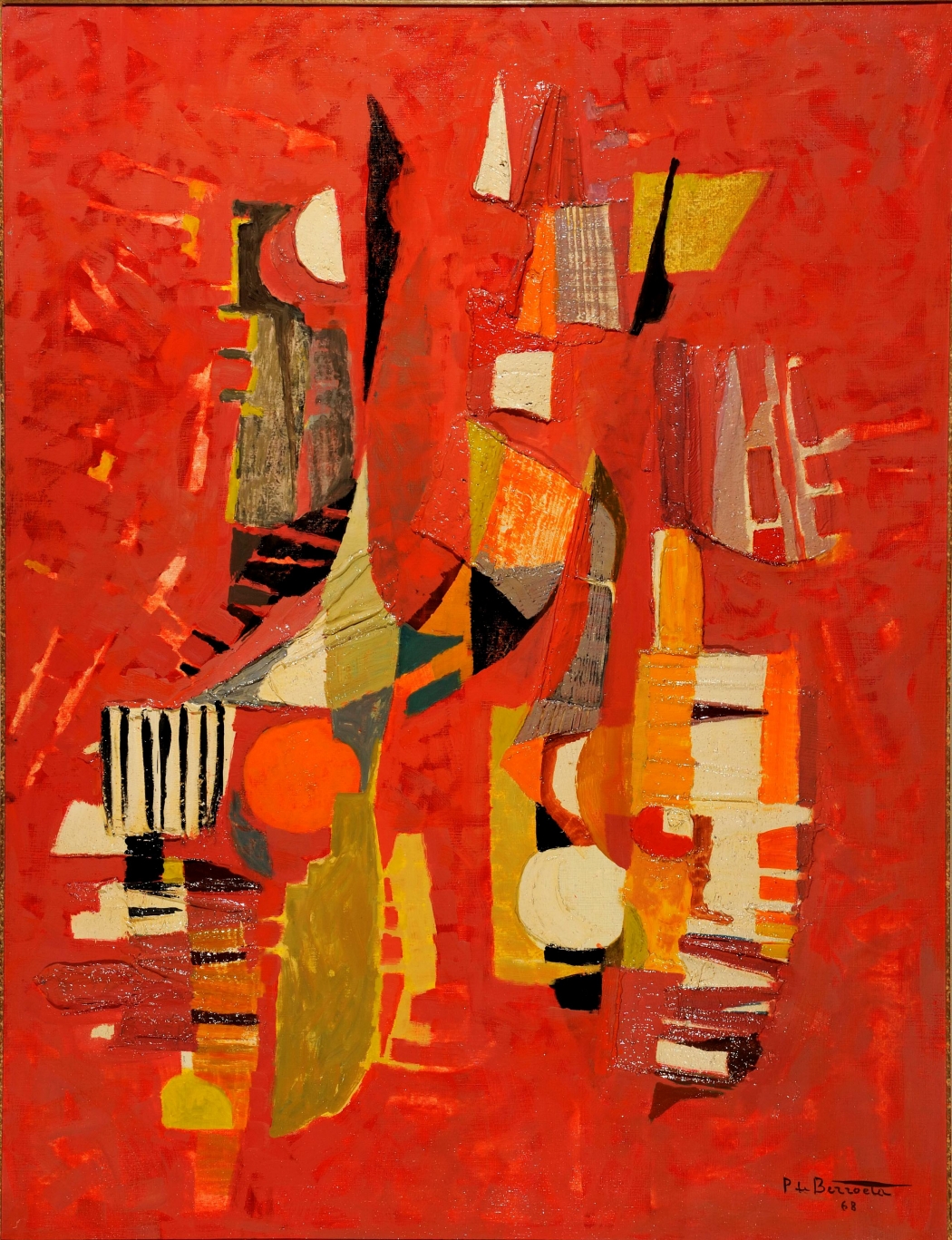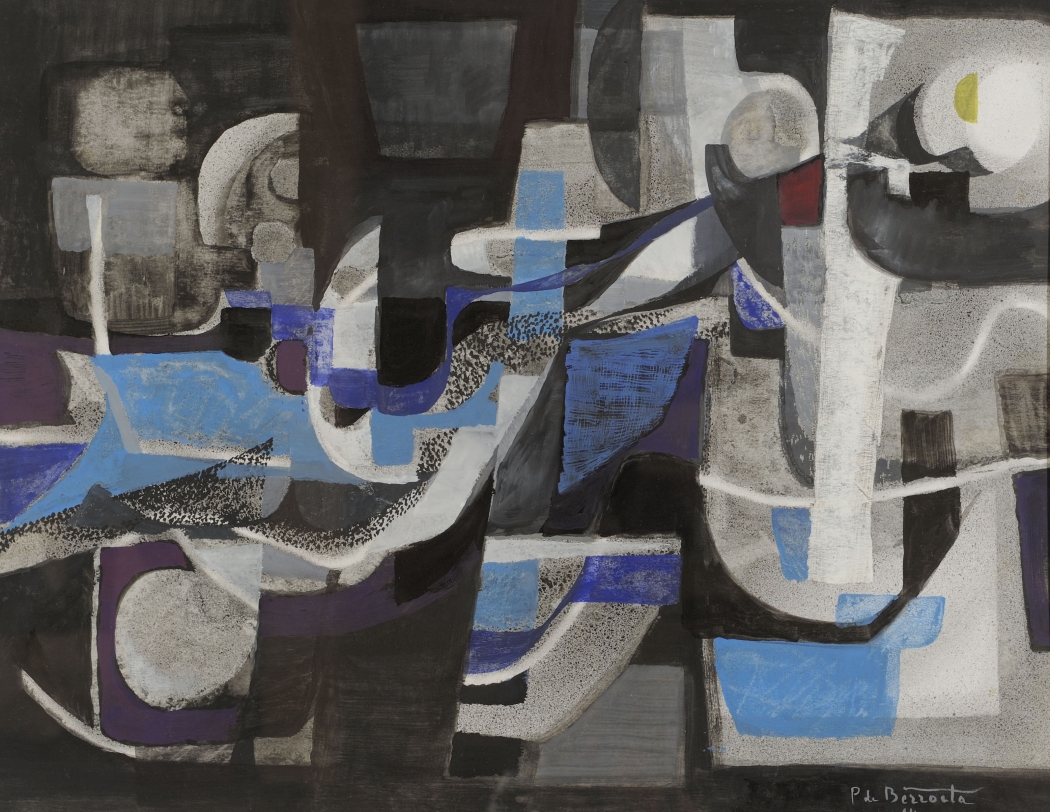
Vernissage Pierre de Berroeta
From 7th December 2009 to 29th January 2010
Angélus presents the exhibition of the artist Pierre de Berroeta. His daughter Marie-Laure Berroeta introduced her father’s works at the private showing. Some works are exhibited at the Chateau.

Biography of Pierre de Berroeta
Pierre Ambroise de Berroeta was born in Paris’ 17th district on 1st April 1914 to Jacques Alfred de Berroeta and his wife Marthe Tinel. Alfred was an industrialist and did business with Argentina in gold- and silverware, but he was above all a passionate art collector of works that have become famous today.
This may have influenced his young son, who when very young displayed great interest in drawing and colours. At the same time as he studied at the renowned Pasteur secondary school in Neuilly, Pierre had drawing lessons from a certain Madame Sampigny and coaching in painting and wood engraving from the painter Clément Cerveau.
Holidays were spent in the Basque country in the family villa in Beyris, which is now a neighbourhood in the city of Bayonne. Although he was a delicate child, Pierre grew up to enjoy robust health able to survive a period of captivity in Stalag IIC.
He was accepted to study in the National Higher School of Fine Arts in Paris in May 1933. He was supervised by André Dewambez, then Charles Guérin. He was the student-elected bursar, then head bursar for the painters of the school. He met another student there, Marguerite Barboteu nicknamed “Guichoune”, and later married her. Chosen to compete for the Prix de Rome scholarship, he was let down by his professor Charles Guérin, who did not support him or even sit on the jury, because he wished to demonstrate his disdain for the institution. As soon as he entered the Paris School of Fine Art, his works were exhibited and they were seen by critics.

Pierre de Berroeta was called for military service on 15th April 1935, which he carried out serving for the 20th logistics squadron in Oberhoffen, Alsace in eastern France. An irrepressible artist, he decorated the regiment’s refectory with a fresco and designed its insignia. After his release in September 1936, he returned to the School of Fine Arts to resume his studies.
He was mobilised in Nancy on 24th August 1939 and assigned to traffic regulation and then to the 172nd engineers. He was taken prisoner immediately after and sent to Stalag IIC at Greifswald in Pomerania on the Baltic coast. The commanding officer of the prison camp seeing Berroeta’s drawings on a variety of sheets, recognised his talent and ordered him to be given paper, pencils, India ink and colours, so that he could draw. This he did … focussing on Parisian monuments and life at the camp. Berroeta was allowed to keep one drawing for every twenty delivered to the Germans. The Army museum has some marked with the stamp “Stalag IIC”. With the help of the camp doctor and two friends, who he stayed in touch with for his whole life, he set up a ploy, which involved losing 40 kilos, and succeeded in being sent back to France!
On his return in June 1941, he married Marguerite Suzanne Charlotte Barboteu in September at the town hall in Neuilly-sur-Seine and at Saint-Ferdinand-des-Ternes church.
He was a prolific artist and tireless worker. At the end of the very year he was released, he took part in three exhibitions. Then further exhibitions followed: the Autumn Salon, the Page Gallery in Bayonne, the Saint-Nazaire Artistic Group and the Daricarrère Gallery in Biarritz. Berroeta was figurative, he liked the circus and exhibited works that were noticed for “the friends of the circus” at the Bouglione Brothers’ Winter Circus.
5th June 1943: Pierre and Guichoune’s only daughter, Marie Laure, was born.
Guichoune’s parents lived in Argentina, so the couple decided to travel there. Apparently their celebrity preceded them, because the Argentinean press announced the arrival of the two artists, while they were still sailing the Atlantic. In Argentina, Pierre de Berroeta painted landscapes, colours, faces of Indians and indigenous animals. He exhibited in the greatest galleries, painted portraits of Argentinean high society personalities, as well as of gauchos and Amerindians. He journeyed to France to show this distant, yet very Europhile country to his compatriots and became one of the best known painters in Argentina.
Pierre de Berroeta never took easy choices nor consciously pursued honours and recognition. He understood that his future was not in Argentina, so he returned to France, where he no longer enjoyed the same recognition, to pursue his research first by becoming a pattern designer, then by exploring abstract design. He produced endlessly reworked studies in which the fundamentals learned at the School of Fine Art were combined with the fruit of his own personal research in a very wide range of fields: shapes, materials, compositions, colours and media. His designs were used for more than 150 tapestries woven at Aubusson, Gobelins and Beauvais to honour official and individual orders. At the same time, Pierre de Berroeta wanted to offer his art to the masses, by giving his patterns for use on mechanical looms, whose products cost less and were therefore available to all.
His figurative work was slowly replaced by abstract studies, laden with doubt and trials with all manner of subjects: portraits, still-life, street scenes, animals, architecture, etc.
In 1958 after visiting Peniscola, he finally made the transition to abstract painting. The only exception was, when challenged by his grandsons, he painted their portraits in less than 5 minutes! His first abstract works have very few colours and seem to bear witness to the intense inner fight he must have undergone when making this radical change. Later, his colours returned along with thicknesses, which typify his works of the 1960’s.
The 1970’s were pictorially rich and enabled him to experiment with other forms of his art: structures built with miscellaneous materials, glass slabs, ceramic tiles, enamelled Volvic lava stone and more tapestries. In the two following decades, he returned to gouache and canvas only. As he pursued happiness by spending more time in the Basque countryside than in Paris, his works display great maturity. Then in 1994, a major change was apparent related to serious health issues in 1993. His vision deteriorated at the end of 2001 and he was forced to retire, which he endured with dignity. Pierre de Berroeta died on 6th February 2004 in Isturitz.


